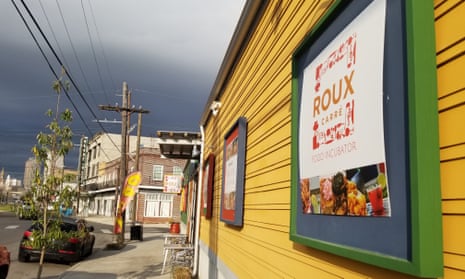Imagine standing in a line for lunch. The customer in front you pays $12 for his food box but when you go to pay for the same product, the chef asks if you’re willing to shell out $30 instead.
Why? Because you’re white.
Would you pay?
That was the premise of a social experiment mounted by New Orleans chef Tunde Wey in February. Much to his own surprise the answer was, for the most part, yes.
Nearly 80% of white customers agreed to pay the inflated price for a pre-fixed Nigerian food box lunch at Wey’s Saartje food stand – after he explained that the request was meant to shine a light on New Orleans’ dramatic and widening income gap.
This article includes content provided by Instagram. We ask for your permission before anything is loaded, as they may be using cookies and other technologies. To view this content, click 'Allow and continue'.
“I wasn’t expecting it,” Wey said. “What was happening at the stall is that I represented a consequence – this personification of accountability.”
Median net income for white families in New Orleans is more than $63,000. For black families, it is just below $26,000. Wey’s $18 food price gap was intended to approximate this earnings gap, which has been growing since cataclysmic flooding after Hurricane Katrina in 2005 radically reshaped the city.
“First I introduce the facts and as a white person, you are now an antagonist in this framework,” Wey said. “But I offer you an easy out. You can pay $12 or you can pay $30. What are you going to do?”
Wey offered to redistribute the extra money back to black patrons, the majority of whom did not take him up on the offer. Some, he said, asked if they could pay $30 too.
Wey identified such reactions, and the willingness of whites to pay more, largely as a function of patrons’ demographics. The Roux Carre foodhall caters to a wealthier crowd. More than 44% of customers, white and black, told researchers they were in the “$65,000 and up” annual income bracket.
Trends still emerged. For example, white patrons who decided to pay the $30 were more likely to be female: 91% of white women did so compared with just 55% of white men.
“I don’t think it’s as difficult to talk to a woman and tell her, ‘There’s something about my personhood that I have nothing to do with and it’s affecting my income and affecting what I can achieve in life,’” said Anjali Prasertong, a nutritionist and writer who was enlisted by Wey to collect data.
“Pretty much every woman has experienced that herself.”
Wey said he thought the experiment may have been more effective at showing how people respond to social pressures than exposing feelings about income inequality.
“Probably talking to him [made me decide to pay $30],” one white patron told researchers. “It made it more of a personal decision. I think it’s a little bit of both, and it’s a little bit of white guilt. I’m like, ‘Yeah, yeah, what else am I going to say? There’s not much!’”
Still, the point of the experiment was not to redistribute wealth. It was to start a conversation.
“This isn’t going to change the racial wealth disparities in the city,” Wey said. “It was meant to show, in principle, what the burden of cost looks like for people who have less resources.”
Wey, who was born in Nigeria, said he was responding to the “Eurocentric perspective of popular food culture”. Inspired by the Black Lives Matter movement, he is planning to mount his next culinary social experiment in Detroit in late April.
